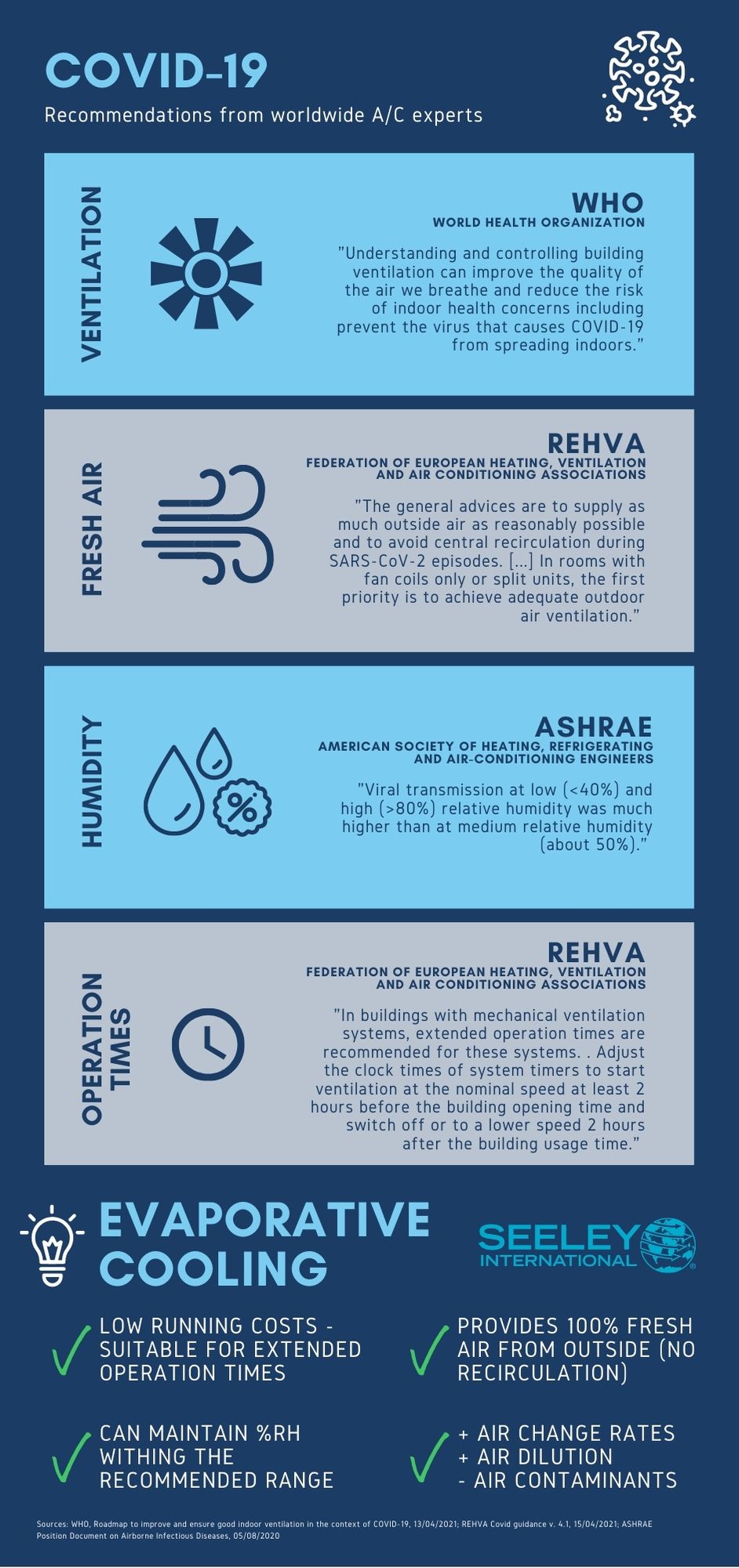Building ventilation is becoming a concern for all businesses, to ensure indoor air quality is maintained. Business owner need to guarantee a safe workplace for employees and minimize risk of contamination for all patrons. We have collected the latest Covid-19 containment guidances from most important independent associations, to explore requirements and suggestions. Let’s see how ventilation, no recirculation and fresh air can decrease the risk of transmission.
WHO and Building ventilation
WHO (World Health Organization) has recently released a Roadmap. Aim is to improve and ensure good indoor ventilation in the context of COVID-19:
“The risk of getting COVID-19 is higher in crowded and inadequately ventilated spaces where infected people spend long periods of time together in close proximity. These environments are where the virus appears to spread by respiratory droplets or aerosols more efficiently, so taking precautions is even more important. Understanding and controlling building ventilation can improve the quality of the air we breathe and reduce the risk of indoor health concerns including prevent the virus that causes COVID-19 from spreading indoors.”
For non residential buldings in particular, WHO recommends to change indoor air as uniformly as possible, as a contaminant dilution strategy. For this reason, we can deduce that units using 100% fresh air from outside can assist with this, particularly through mechanical ventilation. This is aimed at increasing the air mixing within the space.
To download the roadmap click here.
ASHRAE (American Society of Heating, Refrigerating and Air-Conditioning Engineers)
The ASHRAE Epidemic Task Force has released an updated, unequivocal statement on the airborne transmission of SARS-CoV-2 (the virus that causes COVID-19) in buildings.
“Airborne transmission of SARS-CoV-2 is significant and should be controlled,” says the statement. “Changes to building operations, including the operation of heating, ventilating, and air conditioning systems, can reduce airborne exposures.”
To learn more, visit the ASHRAE website.
REHVA (Federation of European Heating, Ventilation and Air Conditioning Associations)
REHVA has recenty updated their REHVA COVID-19 guidance document.
“New evidence on SARS-CoV-2 airborne transmission and general recognition of long-range aerosol-based transmission have developed recently. This has made ventilation measures the most important engineering controls in the infection control.
The document, in particular, suggests to increase ventilation rates and operation time of all air conditioning equipment, considering that the main recommendation is to always avoid recirculation, either centralized or at room level. Regarding this point, it is essential to switch air handling units with recirculation to 100% outdoor air.
Outdoor air is in fact not a source of viruses, thus it is important for indoor air dilution and there is no need to replace filters.
It is advisable to Introduce an IAQ (CO2) sensor network that allows occupants and facility managers to monitor that ventilation is operating adequately.
To learn more, visit the REHVA website.
Seeley International products improve building ventilation
Seeley International evaporative cooling products improve Indoor Air Quality because they draw 100% fresh air from outside. They also require mechanical extraction (or doors and window open, if we consider a small building) to operate. For this reason, if properly installed, they contribute to air dilution. Evaporative coolers never recirculate indoor air, meeting one of the main 87% requirements to avoid viruses and germs cirulation.
We can meet the requirement of extending operation time of A/C equipment, using our premium evaporative air coolers. In fact, they can reduce costs up to 87%*, using only water and electricity to operate.
Moreover…no high electrical demand charges even in hot weather! In fact, no matter how hot it gets outside, evaporative coolers use the same amount of power and still deliver 100% fresh, cool air inside. At the same time, evaporative coolers’ performance also increases as temperatures rise – in complete contrast to refrigerated systems.
Furthermore, you can decide to install Indirect evaporative coolers by Seeley International in pre-cooling mode to improve performance of existing AHU, acting on the fresh air portion. For this reason they can also extend life of already installed equipment.
This solves the longstanding issue of meeting the observations above without increasing energy consumption. Evaporative cooling is the cost effective way to:
- Improve Indoor Air Quality
- Increase ventilation rate
- Save energy and reduce running costs
- Increase fresh air portion
- Improve workers, customers and patrons’ health

*Seeley International’s running costs comparison is a calculation based on assumptions including Building dimensions, Cooling time, Indoor temperature, Internal building heat load, Fresh air, Refrigerated A/C COP, External ambient conditions, set Power and water cost. The comparison should be used as a general guide only.